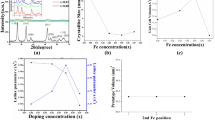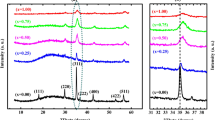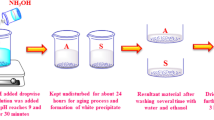Abstract
In this study, iron tin oxide nanocomposites with chemical structure of Fe1.42Sn0.435 O3 (Fe2O3:Sn) were synthesized by coprecipitation method. The effects of annealing temperatures at T = 250 °C, 450 °C, 550 °C, 650 °C and 750 °C on the formation of nanocomposite, crystallite size, morphology and optical, and electrochemical properties were investigated. The iron tin oxide nanoparticles were characterized by X-ray diffraction (XRD), field emission electron microscopy (FESEM), UV-Vis spectroscopy, Fourier-transform infrared spectroscopy (FTIR), cyclic voltammetry (CV), and specific capacitance (SC) analysis. The results obtained from structural analysis for the synthesized samples show that the sample annealed at T = 450 °C has the highest intensity with preferred peak (110) and more uniform grain size. The FESEM images from synthesized nanostructures show the polyhedral and cubic grain with a particle-cluster growth. The band gap (Eg) was determined between 1.96 eV and 2.58 eV, and SFO-2 sample annealed at T = 450 °C is the optimized sample with Eg = 2.20 eV. The FTIR results indicate the formation of tin ferrite oxide structure. The cyclic voltammetry (CV) results are consistent with the redox reactions carried out in hematite metal oxide, tin oxide, and KOH solution. The specific capacitance (SC) analysis for scan rates of 2–200 (mV s−1) shows values between 472–822 (F g−1).













Similar content being viewed by others
Availability of data and materials
The datasets generated during and/or analyzed during the current study are available from the corresponding author upon reasonable request.
References
Olabi A, Maghrabie HM, Adhari OHK, Sayed ET, Yousef BA, Salameh T, Kamil M, Abdelkareem MA (2022) Battery thermal management systems: recent progress and challenges. Int J Thermofluids 15:100171
Olabi A, Abdelkareem M (2021) Energy storage systems towards 2050. Energy 219:119634
Olabi A, Bahri AS, Abdelghafar AA, Baroutaji A, Sayed ET, Alami AH, Rezk H, Abdelkareem MA (2021) Large-scale hydrogen production and storage technologies: current status and future directions. Int J Hydrogen Energy 46(45):23498–23528
David BR, Spencer S, Miller J, Almahmoud S, Jouhara H (2021) Comparative environmental life cycle assessment of conventional and innovative thermal energy storage systems. Int J Thermofluids 12:100116
Abo Khalil AG, Abdelkareem MA, Sayed ET, Maghrabie HM, Radwan A, Rezk H, Olabi A (2022) Electric vehicle impact on energy industry, policy, technical barriers, and power systems. Int J Thermofluids 13:100134
Hasan HA, Togun H, Abed AM, Biswas N, Mohammed HI (2023) Thermal performance assessment for an array of cylindrical lithium-ion battery cells using an air-cooling system. Appl Energy 346:121354
Olabi A, Wilberforce T, Sayed ET, Abo-Khalil AG, Maghrabie HM, Elsaid K, Abdelkareem MA (2022) Battery energy storage systems and SWOT (strengths, weakness, opportunities, and threats) analysis of batteries in power transmission. Energy 254:123987
Chen C, Huang Y, Zhang H, Wang X, Li G, Wang Y, Jiao L, Yuan H (2015) The small amount of reduced graphene oxide modified Li4Ti5O12 nanoparticles for ultrafast high power lithium ion battery. J Power Sources 278:693–702
Pakrouh R, Hosseini M, Ranjbar A, Rahimi M (2023) A novel liquid-based battery thermal management system coupling with phase change material and thermoelectric cooling. J Energy Storage 64:107098
Chen Y, Kang Y, Zhao Y, Wang L, Liu J, Li Y, Liang Z, He X, Li X, Tavajohi N, Li B (2021) A review of lithium-ion battery safety concerns: the issues, strategies, and testing standards. J Energy Chem 59:83–99
Zhou W, Zheng Y, Pan Z, Lu Q (2021) Review on the battery model and SOC estimation method. Processes 9(9):1685
Ali HG, Khan K, Hanif MB, Khan MZ, Hussain I, Javed MS, Motola M (2023) Advancements in two-dimensional materials as anodes for lithium-ion batteries: exploring composition-structure-property relationships emerging trends, and future perspective. J Energy Storage 73:108980
Colombo R, Versaci D, Amici J, Bella F, Para ML, Garino N, Francia C (2023) Reduced graphene oxide embedded with ZnS nanoparticles as catalytic cathodic material for Li-S batteries. Nanomaterials 13(14):2149
Alidoost M, Mangini A, Caldera F, Anceschi A, Amici J, Versaci D, Bodoardo S (2022) Micro-mesoporous carbons from cyclodextrin nanosponges enabling high-capacity silicon anodes and sulfur cathodes for lithiated Si-S batteries. Chem Eur J 28(6):e202104201
Xu Z, Zhang Q, Ji Q, Gao X, Chen G, Xie S, Xia Y (2023) Facile scalable multilevel structure engineering makes Ti0.667Nb1.333O4 a new promising lithium-ion battery anode. Mater Today Sustain 24:100521
Colombo R, Garino N, Versaci D, Amici J, Para ML, Quartarone E, Bodoardo S (2022) Designing a double-coated cathode with high entropy oxides by microwave-assisted hydrothermal synthesis for highly stable Li–S batteries. J Mater Sci 57(33):15690–15704
Abdah MAAM, Mokhtar M, Khoon LT, Sopian K, Dzulkurnain NA, Ahmad A, Su’ait, M S, (2021) Synthesis and electrochemical characterizations of poly (3, 4-ethylenedioxythiophene/manganese oxide coated on porous carbon nanofibers as a potential anode for lithium-ion batteries. Energy Rep 7:8677–8687
Lefrançois Perreault L, Colò F, Meligrana G, Kim K, Fiorilli S, Bella F, Gerbaldi C (2018) Spray-dried mesoporous mixed Cu-Ni Oxide@ Graphene nanocomposite microspheres for high power and durable Li-ion battery anodes. Adv Energy Mater 8(35):1802438
Wu D, Wang C, Wu H, Wang S, Wang F, Chen Z, Zhao T, Zhang Z, Zhang LY, Li CM (2020) Synthesis of hollow Co3O4 nanocrystals in situ anchored on holey graphene for high-rate lithium-ion batteries. Carbon 163:137–144
Ateia EE, Hussien S, Mohamed AT (2023) Tuning the structural and magnetic properties of the stuffed framework structures MeFe2O4 (Me = Ni, Ca, and Sr). J Inorg Organomet Polym 33:216–227
Dehghani DO, Shokrollahi H, Mirshekari S (2023) A review of soft spinel ferrites’ synthesis, characterization, and magnetic properties. Inorg Chem Commun 153:110797
Soufi A, Hajjaoui H, Elmoubarki R, Abdennouri M, Gourzal S, Barka N (2021) Spinel ferrites nanoparticles: synthesis methods and application in heterogeneous Fenton oxidation of organic pollutants : a review. Appl Surf Sci Adv 6:100145
Matsubara N, Masese T, Suard E, Forslund OK, Nocerino E, Palm R, Månsson M (2020) Cation distributions and magnetic properties of ferrispinel MgFeMnO4. Inorg Chem 59(24):17970–17980
Yasuda K, Azuhiro C, Baldinozzi J (2020) Radiation-induced effects on material properties of ceramics: mechanical and dimensional properties. Elsevier
Ramadevi P, Shanmugavadivu R, Venkatesan R, Mayandi J, Sagadevan S (2023) Photocatalytic dye degradation efficiency and reusability of aluminium substituted nickel ferrite nanostructures for wastewater remediation. Inorg Chem Commun 150:110532
Allen JL, Crear BA, Choudhury R, Wang MJ, Tran DT, Ma L, Piccoli PM, Sakamoto J, Wolfenstine J (2020) Fast Li-Ion conduction in spinel-structured solids. Molecules 26(9):2625
Islam M, Rahman K, Kumar MK, Rahman A, Abdullah Al Mamun MM, Rashid M, Haque RMM, Islam Sarker MS (2022) Sol gel route for the synthesis of CoFe2xErxO4 nanocrystalline ferrites and the investigation of structural and magnetic properties for magnetic device applications. ACS Omega 7(24):20731–20740
Mmelesi OK, Masunga N, Kuvarega A, Nkambule TT, Mamba BB, Kefeni KK (2021) Cobalt ferrite nanoparticles and nanocomposites: photocatalytic, antimicrobial activity and toxicity in water treatment. Mater Sci Semicond Process 123:105523
Wang C, Ma S, Li D, Zhao J, Zhou H, Wang D, Liu C, Wang S, Chen C (2023) Direct ink writing of thermoresistant, lightweight composite polyimide honeycombs with tunable X-band electromagnetic wave absorption properties. Addit Manuf 70:103554
Senthilkumar SH, Ramasubramanian B, Rao RP, Chellappan V, Ramakrishna S (2022) Advances in electrospun materials and methods for Li-Ion batteries. Polymers 15(7):1622
Henriques A, Rabiei Baboukani A, Jafarizadeh B, Chowdhury AH, Wang C (2021) Nano-confined tin oxide in carbon nanotube electrodes via electrostatic spray deposition for lithium-ion batteries. Materials 15(24):9086
Paul S, Rahman MA, Sharif SB, Kim J, Siddiqui S, Hossain MA (2021) TiO2 as an anode of high-performance lithium-ion batteries: a comprehensive review towards practical application. Nanomaterials 12(12):2034
Ramasubramanian A, Yurkiv V, Nie A, Najafi A, Khounsary A, Shahbazian Yassar R, Mashayek F (2019) A numerical study on striped lithiation of tin oxide anodes. Int J Solids Struct 159:163–170
Yang R, Wen J, Zhou Y, Song K, Song Z (2018) Effect of Al element on the microstructure and properties of Cu-Ni-Fe-Mn alloys. Materials 11:9
Zhou F, Sun Y, Liu S, Nan J (2016) Synthesis of SnFe2O4 as a novel anode material for lithium-ion batteries. Solid State Ion 296:163–167
Sun Y, Huang M, Guan D, Zhang G, Wei J, Nan J, Yi F (2021) Influence of the Sn(Fe)–C bonds content in SnFe2O4@reduced graphene oxide composites on the electrochemical behavior of lithium-ion batteries. J Alloy Compd 854:157297
Guan D, Tian S, Sun Y, Deng F, Nan J, Ma G, Cai Y (2019) Investigation of the electrochemical properties and kinetics of a novel SnFe2O4@nitrogen-doped carbon composite anode for lithium-ion batteries. Electrochim Acta 322:134722
He J, Zhang T, Zhang M, Feng C, Liu Z, Chen X (2023) Synthesis and electrochemical properties of Bi2WO6/C anode for lithium ion battery. J Solid State Electrochem 1–11
Fu Y, Li J, Wang H et al (2023) Synthesis of FeS2/CoS heterostructure microspheres as anodes for high-performance Li-ion batteries. J Solid State Electrochem 27:2523–2531
Zhang W, Bao J, Lu C, Zhou X, Xia X, Zhang J, Xia Y (2023) Solvothermal synthesis of TiNb2O7 microspheres as anodic materials for high-performance lithium–ion batteries. J Solid State Electrochem 1–9
Zhou Z, Feng Y, Wang J, Liang B, Li Y, Song Z, Song J (2020) A robust, highly stretchable ion-conducive skin for stable lithium metal batteries. Chem Eng J 396:125254
Zeng T, Meng X, Huang H, Zheng L, Chen H, Zhang Y, Yuan W, Zhang LY (2022) Controllable synthesis of web-footed PdCu nanosheets and their electrocatalytic applications. Small 18(14):2107623
Zeng T, Zheng L, Chen H, Wang Y, Ling M, Sun S, Zhang F, Yuan W, Zhang LY (2023) One-pot controllable epitaxial growth of Pd-based heterostructures for enhanced formic acid oxidation. Colloids Surf A 656:130358
Liu S, Zhang W, An Y et al (2023) A high-performance binder-free freestanding film anode constructed by Si/NC nanoparticles anchoring in 3D porous N-doped graphene-CNTs networks for Li-ion batteries. J Solid State Electrochem 27:1165–1175
Jiang T, Wu F, Ren Y et al (2023) Pyrochlore phase (Y, Dy, Ce, Nd, La)2Sn2O7 is a superb anode material for lithium-ion batteries. J Solid State Electrochem 27:763–772
Wang ZY, Lu ZX, Guo W, Luo Q, Yin YH, Bin Liu X (2020) A dendrite-free lithium / carbon nanotube hybrid for lithium-metal batteries. Adv Mater 2006702:1–9
Yong E, Nam D, Kim Y, Kim K, Kim B, Ko Y, Cho J (2023) An electrochemically active textile current collector with a high areal capacity and a strong energy recovery effect using an interfacial interaction assembly. Energy Storage Mater 60:102813
Tian B, Huang Z, Xu X, Cao X, Wang H, Xu T, Kong D, Zhang Z, Xu J, Zang J, Li X, Wang Y (2022) Three-dimensional Ag/carbon nanotube-graphene foam for high-performance dendrite free lithium/sodium metal anodes. J Mater Sci Technol 132:50–58
Lu L, Pei YT (2021) Interfacial modification by lipophilic oxide facilitates uniform and thin solid electrolyte interphase towards stable lithium metal anodes. Mater Today Energy 21:100748
Liu S, Zhang H, Liu X, Yang Y, Chi C, Wang S, Li Y (2021) Constructing nanoporous Ni foam current collectors for stable lithium metal anodes. J Energy Chem 58:124–132
Zhu Q, Ye C, Mao D (2021) Solid-state electrolytes for lithium-sulfur batteries: challenges, progress, and strategies. Nanomaterials 12(20):3612
Abd-Elrahman NK, Al-Harbi N, Basfer NM, Al-Hadeethi Y, Umar A, Akbar S (2021) Applications of nanomaterials in microbial fuel cells: a review. Molecules 27(21):7483
Yoon H, Matteini P, Hwang B (2022) Effect of the blade-coating conditions on the electrical and optical properties of transparent Ag nanowire electrodes. Micromachines 14(1):114
Villars P, Cenzual K, Daams J, Gladyshevskii R, Shcherban O, Dubenskyy V, Stoyko S (2009) Crystal structures of inorganic compounds, vol 43. Springer-Verlag, Berlin Heidelberg
Grabmann S, Bernauer C, Wach L, Leeb M, Zaeh MF (2023) A method for the reproducible and accurate determination of electrical resistances based on multi-layer joints in lithium-ion batteries. Appl Energy 349:121613
Funding
The authors declare that no funds, grants, or other support were received during the preparation of this manuscript.
Author information
Authors and Affiliations
Contributions
All authors contributed to the study's conception and design. Material preparation, data collection, and analysis were performed by Ghasem Sedaghati-Jamalabad and M. M. Bagheri-Mohagheghi. The first draft of the manuscript was written by Ghasem Sedaghati-Jamalabad and all authors commented on previous versions of the manuscript. All authors read and approved the final manuscript.
Corresponding author
Ethics declarations
Ethical approval
Not applicable.
Conflict of interest
The authors declare no conflict of interest.
Competing interests
The authors have no relevant fnancial or non-financial interests to disclose.
Additional information
Publisher's Note
Springer Nature remains neutral with regard to jurisdictional claims in published maps and institutional affiliations.
Rights and permissions
Springer Nature or its licensor (e.g. a society or other partner) holds exclusive rights to this article under a publishing agreement with the author(s) or other rightsholder(s); author self-archiving of the accepted manuscript version of this article is solely governed by the terms of such publishing agreement and applicable law.
About this article
Cite this article
Sedaghati-Jamalabad, G., Bagheri-Mohagheghi, M.M. Synthesis and study of structural, optical, and electrochemical properties of iron tin oxide nanoparticles. J Solid State Electrochem (2023). https://doi.org/10.1007/s10008-023-05728-y
Received:
Revised:
Accepted:
Published:
DOI: https://doi.org/10.1007/s10008-023-05728-y




